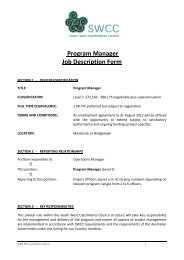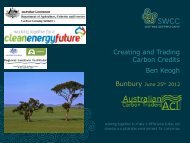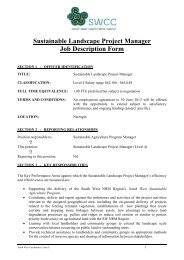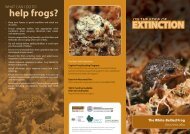Tender for the Programme - South West Catchments Council
Tender for the Programme - South West Catchments Council
Tender for the Programme - South West Catchments Council
You also want an ePaper? Increase the reach of your titles
YUMPU automatically turns print PDFs into web optimized ePapers that Google loves.
DRAFT<br />
<strong>South</strong> <strong>West</strong> Regional NRM Strategy – Ancillary Document<br />
And <strong>the</strong>n <strong>the</strong>re is aquaculture, which is expected to supply 50% of seafood by 2015. Already <strong>the</strong><br />
abundance of large predators has been reduced in most oceans, with more dramatic declines in<br />
intensively used areas, such as <strong>the</strong> North Atlantic. Shallow seabeds are extensively trawled. The rate of<br />
infrastructure construction, especially <strong>for</strong> <strong>the</strong> production of renewable energy, is accelerating. Although<br />
none of <strong>the</strong>se individual issues is highly novel, <strong>the</strong>se rapid, simultaneous developments across multiple<br />
sectors will probably have a dramatic impact on <strong>the</strong> oceans and <strong>the</strong> species that <strong>the</strong>y support.<br />
See Su<strong>the</strong>rland et al. (2011) <strong>for</strong> fur<strong>the</strong>r in<strong>for</strong>mation.<br />
7.12 Groundwater contamination<br />
The threat to environmental quality posed by open-cast mining of oil sands has been widely highlighted,<br />
but comparatively little attention has been paid to <strong>the</strong> threats arising from hydraulic fracturing (also known<br />
as “fracking”) to extract natural gas from organic-rich shale basins. This technology is proposed <strong>for</strong> a<br />
number of sites across Australia, including some in <strong>the</strong> south west.<br />
Depending on site conditions, hydraulic fracturing at a single horizontal well might require pumping of<br />
8,000-38,000 tons of water-based fracturing fluids at high pressure into <strong>the</strong> bedrock. The pumping creates<br />
fractures that enable <strong>the</strong> subsequent flow of gas out to <strong>the</strong> wellhead. This generally occurs usually far<br />
below any aquifers and wells can be effectively sealed to prevent leakage. Never<strong>the</strong>less, <strong>the</strong>re have been<br />
cases of pollution of both surface water and aquifers, and of gas leakage.<br />
This is of concern, as fracturing fluids contain several toxic chemicals, including naphthalene, butanol,<br />
fluorocarbons and <strong>for</strong>maldehyde, which are considered carcinogenic and are linked to numerous human<br />
illnesses. Gas companies are not required to disclose <strong>the</strong> composition of fluids, which could result in less<br />
effective treatment by wastewater plants.<br />
The high quantities of water required <strong>for</strong> fracturing are typically extracted on-site from groundwater or<br />
nearby streams, and this could affect aquatic ecology and public water resources. The growth of this<br />
industry across <strong>the</strong> USA and elsewhere is considerable. This again is of concern, as <strong>the</strong> spatial reach of<br />
each well is limited so that a high density of wells, access roads and pipelines is needed <strong>for</strong><br />
comprehensive gas extraction, creating a footprint that is affecting large areas of natural landscapes in <strong>the</strong><br />
USA.<br />
See Su<strong>the</strong>rland et al. (2011) <strong>for</strong> fur<strong>the</strong>r in<strong>for</strong>mation.<br />
7.13 New invasive species<br />
There are a number of serious pest species that may impact on NRM in <strong>the</strong> south west in <strong>the</strong> future.<br />
These not only include <strong>the</strong> well-known Cane toad, but also <strong>the</strong> much less known Asian bee, Apis cerana,<br />
which has decimated <strong>the</strong> honey bee industry in <strong>the</strong> Solomons (reducing hive numbers from >2000 to just<br />
5). Un<strong>for</strong>tunately, in February 2011, a decision was taken by a majority of State governments to end<br />
control ef<strong>for</strong>ts (see Cribb 2012, accessed on 17/3/2012 at<br />
http://www.onlineopinion.com.au/view.asparticle=11661).<br />
Many notable ecologists believe, however, that <strong>the</strong> case against non-native species is often overplayed<br />
and that it is time to study each such species on a case by case basis, ensuring that both positive and<br />
negative impacts are well-known be<strong>for</strong>e “damning” <strong>the</strong> species (Davis et al 2011 – see<br />
http://www.nature.com/nature/journal/v474/n7350/full/474153a.html and also<br />
http://www.nature.com/nature/journal/v474/n7350/full/474153a.html <strong>for</strong> a response).<br />
7.14 Global financial instability<br />
The recent economic crises around <strong>the</strong> globe have spooked many investors and reduced <strong>the</strong> amount of<br />
investment funding available. Impacts have been largely contained in Australia, probably due to <strong>the</strong><br />
217






